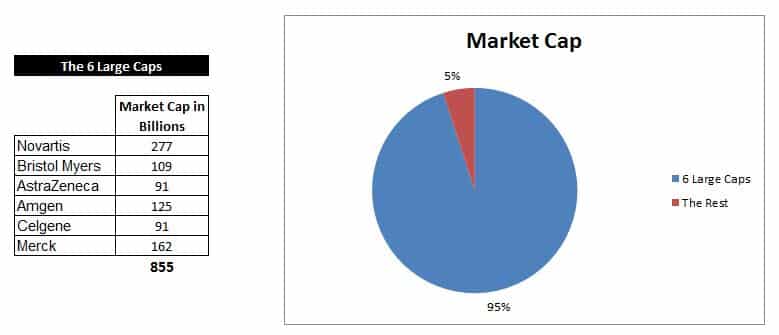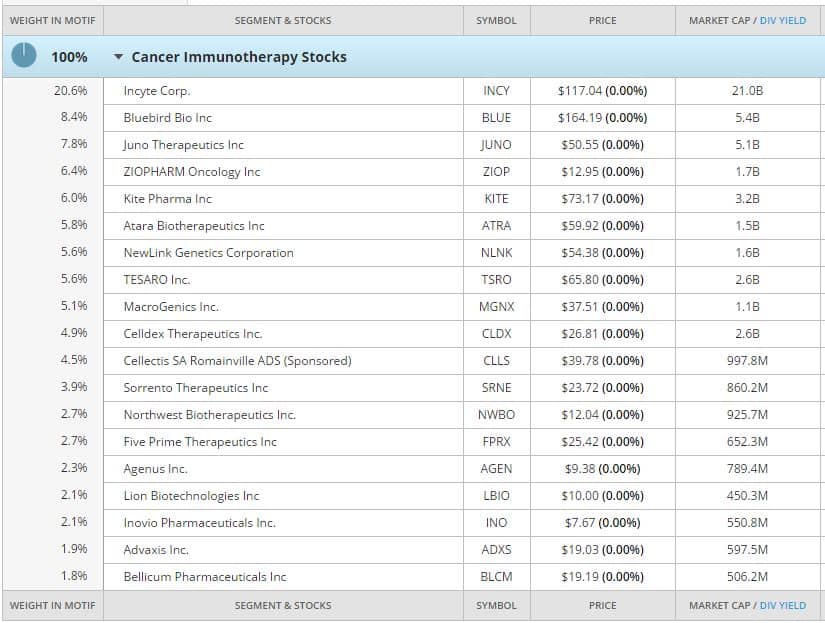Investing in Cancer Immunotherapy Companies

In 2013, Goldman Sachs identified 8 disruptive technologies for investors to watch, among them 3D printing, LED Lighting and something called “cancer immunotherapy“. While this has been heavily followed by biotech investors in the past, the term is just now becoming more mainstream since Vice News published a special report on HBO last month titled “Killing Cancer” in which they generated a great deal of hype around some dramatically new ways to fight cancer that involve using viruses to provoke the immune system to attack cancer; measles for bone cancer, HIV for blood cancer, and the common cold virus for brain cancer. Researchers hope to find viruses that can kill the over 300 types of cancer that exist. And that’s just one way that “cancer immunotherapy” uses the body’s own immune system to fight cancer.
While biotech investors have been watching the cancer immunotherapy “sector” closely, it’s just recently that many people are first hearing about this disruptive technology. The Vice Report claimed that the medical community is now ready to announce that we’re at the first stage to cure cancer. But why are we just now hearing about this? Because the medical community hasn’t been allowed to go public with the results until now, it’s happening in real time, it’s literally breaking news, etc. The report talked about the biggest success being the work of Dr. Carl Jun who has a 90% success rate using cancer immunotherapy methods to attack blood cancers. In an interview posted by the Cancer Research Institute, Dr. Jun talks in depth about some very promising early successes. After four years of ongoing trials, commercialization is expected to happen next year. Is this the “cure for cancer” everyone’s been waiting to invest in?
While the report generated a great deal of interest, experts felt the case by Vice was overstated. Nevertheless, cancer immunotherapy sounds like a promising field to invest in. Just a few weeks ago, the first cancer immunotherapy index, the Loncar Cancer Immunotherapy Index, was released moving this “sector” one step closer to investors. Quotes for the Loncar Cancer Immunotherapy Index can be found each day under the symbol “LCINDX” on the Bloomberg Professional service, or at www.LoncarIndex.com
The index portfolio has a target composition of 25 companies. First, the index picks the top six large-cap pharmaceutical companies who are working on cancer on immunotherapy. The overall market cap of these companies dominates the remaining portfolio as seen below:
Consequently, the index is not market cap-weighted but rather equally weights each stock in the portfolio. This means that 24% of the index returns will be highly correlated to the overall biotech industry as one would expect from a collection of large caps. The remaining 75% of returns will come from the top 19 growth biotechnology companies in “cancer immunotherapy” by market capitalization as seen below:
| Company Name | Ticker | Market Cap Billions | Weight |
| Incyte Corporation | (NASDAQ:INCY) | 18.29 | 39.8% |
| Juno Therapeutics | (NASDAQ:JUNO) | 5.05 | 11.1% |
| bluebird bio | (NASDAQ:BLUE) | 4.29 | 9.4% |
| Celldex Therapeutics | (NASDAQ:CLDX) | 2.75 | 6.1% |
| Tesaro, Inc. | (NASDAQ:TSRO) | 2.52 | 5.6% |
| Kite Pharma | (NASDAQ:KITE) | 2.50 | 5.5% |
| NewLink Genetics | (NASDAQ:NLNK) | 1.50 | 3.3% |
| ZIOPHARM Oncology | (NASDAQ:ZIOP) | 1.41 | 3.2% |
| Atara Biotherapeutics | (NASDAQ:ATRA) | 1.31 | 3.0% |
| Cellectis | (NASDAQ:CLLS) | 1.03 | 2.4% |
| MacroGenics, Inc. | (NASDAQ:MGNX) | 1.00 | 2.2% |
| Bellicum Pharmaceuticals | (NASDAQ:BLCM) | 0.70 | 1.6% |
| Inovio | (NASDAQ:INO) | 0.64 | 1.5% |
| Five Prime Therapeutics | (NASDAQ:FPRX) | 0.61 | 1.4% |
| Northwest Biotherapeutics | (NASDAQ:NWBO) | 0.55 | 1.3% |
| Advaxis | (NASDAQ:ADXS) | 0.55 | 1.4% |
| Lion Biotechnologies | (NASDAQ:LBIO) | 0.53 | 1.2% |
| Agenus, Inc. | (NASDAQ:AGEN) | 0.41 | 1.0% |
| Sorrento Therapeutics | (NASDAQ:SRNE) | 0.40 | 0.9% |
| Total Market Cap | 46.03 Billion |
So how does one go about investing in this index? The answer is you can’t yet without buying all 25 stocks and then rebalancing your portfolio twice a year. The transactions costs make this a non-option for most investors. Currently, there is no ETF or financial product that currently tracks this index.
So if an investor wants pure-play exposure to “cancer immunotherapy”, what’s the best way to do so without having to purchase all 25 stocks? Well firstly, we’d drop big pharma from the list because these companies are far too correlated to the broader index and we’re looking to get in on the real growth potential here. The 19 companies remaining only represent a cumulative market cap of 46 billion or about one-sixth the size of Novartis. So how can you purchase all 19 companies while keeping transaction costs manageable? Just join the Motif investing platform and then buy the Nanalyze Cancer Immunotherapy Stocks motif as seen below:
For just $9.95 per trade you can buy the entire basket of 19 stocks. You could even create your own motif and choose which stocks you want to include and at which weightings. Since most of us don’t have the time nor the expertise to stock pick in this “sector”, we look to buy a basket of stocks instead so that if one turns out to go bankrupt, there are plenty of others to offset that sharp loss. Diversification is key here because risks are high. A Seattle based company, Dendreon, announced FDA approval for the first cancer immunotherapy drug in April 2010. Late last year, Dendreon went bankrupt.
The exciting potential of cancer immunotherapy will no doubt attract a handful of “me too” over-the-counter (OTC) companies that will try to attach themselves to this growth story. Notice that none of the stocks in this index are OTC companies and one reason for that is the Loncar Index Methodology which requires a minimum market cap of $100 million for index inclusion and considers other factors such as “reputation of scientific excellence”.
Around 10 years ago, nanotechnology was being touted as the next greatest thing for the healthcare industry. Working at the nano level, we would soon be able to build ‘little machines” that go through the bloodstream killing cancer cells. Synthetically modifying a virus and then programming it to attack cancer cells doesn’t sound too far off from that prediction. Steve Jobs may have been right when he said that greatest innovations of the 21st century will be at the intersection of biotechnology and technology.
Sign up to our newsletter to get more of our great research delivered straight to your inbox!
Nanalyze Weekly includes useful insights written by our team of underpaid MBAs, research on new disruptive technology stocks flying under the radar, and summaries of our recent research. Always 100% free.
















GenSpera is a bio-tech company based out of San Antonio, Tx. They are looking for investors to continue
their research and clinical trials as well as pro drug cancer theraputics.